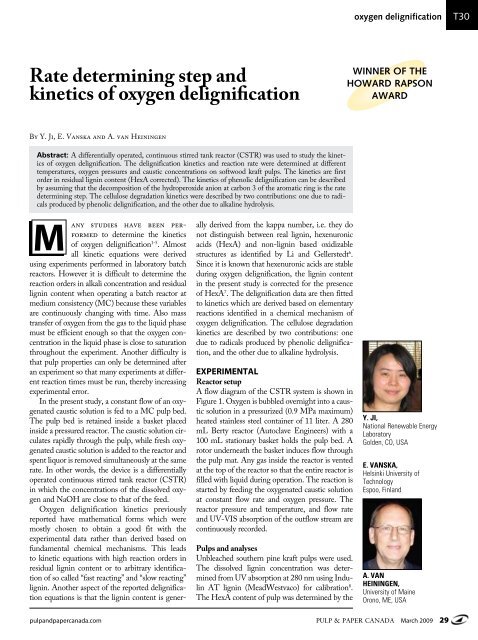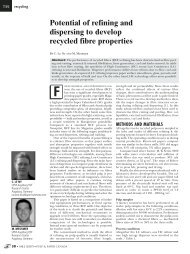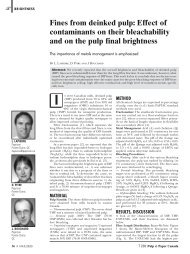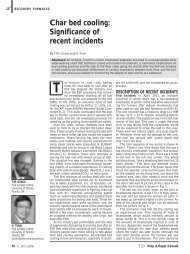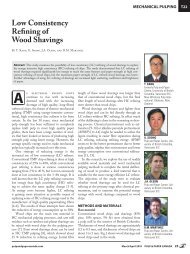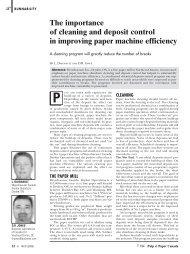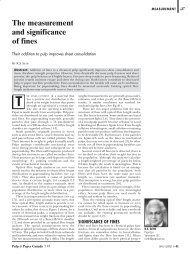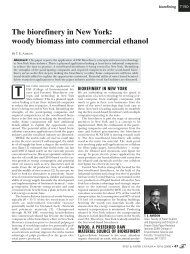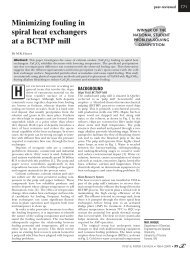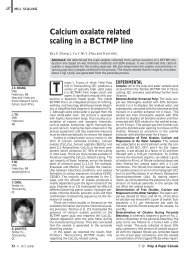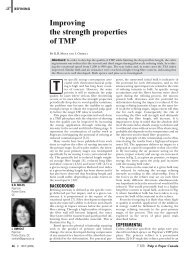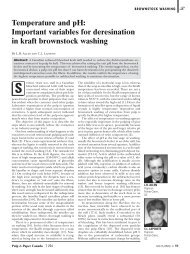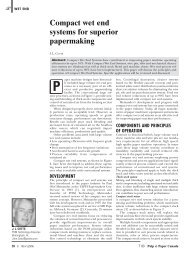Rate determining step and kinetics of oxygen delignification
Rate determining step and kinetics of oxygen delignification
Rate determining step and kinetics of oxygen delignification
Create successful ePaper yourself
Turn your PDF publications into a flip-book with our unique Google optimized e-Paper software.
<strong>oxygen</strong> <strong>delignification</strong>T30<strong>Rate</strong> <strong>determining</strong> <strong>step</strong> <strong>and</strong><strong>kinetics</strong> <strong>of</strong> <strong>oxygen</strong> <strong>delignification</strong>WINNER OF THEHOWARD RAPSONAWARDBy Y. Ji, E. Vanska <strong>and</strong> A. van HeiningenAbstract: A differentially operated, continuous stirred tank reactor (CSTR) was used to study the <strong>kinetics</strong><strong>of</strong> <strong>oxygen</strong> <strong>delignification</strong>. The <strong>delignification</strong> <strong>kinetics</strong> <strong>and</strong> reaction rate were determined at differenttemperatures, <strong>oxygen</strong> pressures <strong>and</strong> caustic concentrations on s<strong>of</strong>twood kraft pulps. The <strong>kinetics</strong> are firstorder in residual lignin content (HexA corrected). The <strong>kinetics</strong> <strong>of</strong> phenolic <strong>delignification</strong> can be describedby assuming that the decomposition <strong>of</strong> the hydroperoxide anion at carbon 3 <strong>of</strong> the aromatic ring is the rate<strong>determining</strong> <strong>step</strong>. The cellulose degradation <strong>kinetics</strong> were described by two contributions: one due to radicalsproduced by phenolic <strong>delignification</strong>, <strong>and</strong> the other due to alkaline hydrolysis.Many studies have been performedto determine the <strong>kinetics</strong><strong>of</strong> <strong>oxygen</strong> <strong>delignification</strong> 1-5 . Almostall kinetic equations were derivedusing experiments performed in laboratory batchreactors. However it is difficult to determine thereaction orders in alkali concentration <strong>and</strong> residuallignin content when operating a batch reactor atmedium consistency (MC) because these variablesare continuously changing with time. Also masstransfer <strong>of</strong> <strong>oxygen</strong> from the gas to the liquid phasemust be efficient enough so that the <strong>oxygen</strong> concentrationin the liquid phase is close to saturationthroughout the experiment. Another difficulty isthat pulp properties can only be determined afteran experiment so that many experiments at differentreaction times must be run, thereby increasingexperimental error.In the present study, a constant flow <strong>of</strong> an <strong>oxygen</strong>atedcaustic solution is fed to a MC pulp bed.The pulp bed is retained inside a basket placedinside a pressured reactor. The caustic solution circulatesrapidly through the pulp, while fresh <strong>oxygen</strong>atedcaustic solution is added to the reactor <strong>and</strong>spent liquor is removed simultaneously at the samerate. In other words, the device is a differentiallyoperated continuous stirred tank reactor (CSTR)in which the concentrations <strong>of</strong> the dissolved <strong>oxygen</strong><strong>and</strong> NaOH are close to that <strong>of</strong> the feed.Oxygen <strong>delignification</strong> <strong>kinetics</strong> previouslyreported have mathematical forms which weremostly chosen to obtain a good fit with theexperimental data rather than derived based onfundamental chemical mechanisms. This leadsto kinetic equations with high reaction orders inresidual lignin content or to arbitrary identification<strong>of</strong> so called “fast reacting” <strong>and</strong> “slow reacting”lignin. Another aspect <strong>of</strong> the reported <strong>delignification</strong>equations is that the lignin content is gener-ally derived from the kappa number, i.e. they donot distinguish between real lignin, hexenuronicacids (HexA) <strong>and</strong> non-lignin based oxidizablestructures as identified by Li <strong>and</strong> Gellerstedt 6 .Since it is known that hexenuronic acids are stableduring <strong>oxygen</strong> <strong>delignification</strong>, the lignin contentin the present study is corrected for the presence<strong>of</strong> HexA 7 . The <strong>delignification</strong> data are then fittedto <strong>kinetics</strong> which are derived based on elementaryreactions identified in a chemical mechanism <strong>of</strong><strong>oxygen</strong> <strong>delignification</strong>. The cellulose degradation<strong>kinetics</strong> are described by two contributions: onedue to radicals produced by phenolic <strong>delignification</strong>,<strong>and</strong> the other due to alkaline hydrolysis.ExperimentalReactor setupA flow diagram <strong>of</strong> the CSTR system is shown inFigure 1. Oxygen is bubbled overnight into a causticsolution in a pressurized (0.9 MPa maximum)heated stainless steel container <strong>of</strong> 11 liter. A 280mL Berty reactor (Autoclave Engineers) with a100 mL stationary basket holds the pulp bed. Arotor underneath the basket induces flow throughthe pulp mat. Any gas inside the reactor is ventedat the top <strong>of</strong> the reactor so that the entire reactor isfilled with liquid during operation. The reaction isstarted by feeding the <strong>oxygen</strong>ated caustic solutionat constant flow rate <strong>and</strong> <strong>oxygen</strong> pressure. Thereactor pressure <strong>and</strong> temperature, <strong>and</strong> flow rate<strong>and</strong> UV-VIS absorption <strong>of</strong> the outflow stream arecontinuously recorded.Pulps <strong>and</strong> analysesUnbleached southern pine kraft pulps were used.The dissolved lignin concentration was determinedfrom UV absorption at 280 nm using IndulinAT lignin (MeadWestvaco) for calibration 8 .The HexA content <strong>of</strong> pulp was determined by theY. Ji,National Renewable EnergyLaboratoryGolden, CO, USAE. Vanska,Helsinki University <strong>of</strong>TechnologyEspoo, Finl<strong>and</strong>A. vanHeiningen,University <strong>of</strong> MaineOrono, ME, USApulp<strong>and</strong>papercanada.com Pulp & Paper Canada March 2009 29
T31<strong>oxygen</strong> <strong>delignification</strong>Fig. 1. Flow diagram <strong>of</strong> the continuous stirred tank reactor(CSTR) system.Fig. 2. Delignification rate vs. residual lignin at different O 2pressures.where the constant K c= K HL*·[HL *total]·C.The reaction rate constant, k, is obtainedfrom the slope <strong>of</strong> the <strong>delignification</strong> rateversus L ccurve shown in Figure 2 fora commercial unbleached southern pinekraft pulp (Kappa 26). The linear decreasein <strong>delignification</strong> rate with HexA-freeresidual lignin content, L C, can be intermethod<strong>of</strong> Tenkanen et al. scaled down to200 mg pulp 9 . The residual lignin contentin pulp, L c, was calculated asHexA mg ligninL c= ( Kappa – ––––– ) 31.5 ( –—––––– ) (1)10 g pulpwhere the kappa number is calculated as theinitial pulp kappa number minus the amount<strong>of</strong> lignin dissolved as measured by UV. Thekappa number is corrected for the HexAcontent (in µmol/g pulp). Since 10 µmol/g <strong>of</strong>HexA is equivalent to one kappa unit 10 , theHexA content is divided by 10. The factor1.5 is the st<strong>and</strong>ard conversion <strong>of</strong> kappa to mglignin per gram <strong>of</strong> pulp. Ji has shown that theHexA content <strong>of</strong> pulp does not change during<strong>oxygen</strong> <strong>delignification</strong> except when a severeyield loss occurs so that HexA groups areremoved together with the carbohydrates 11 .The phenolic hydroxyl group content <strong>of</strong> theliquor <strong>and</strong> the pulp was determined from thedifference in UV absorbance <strong>of</strong> neutral <strong>and</strong>alkaline solutions at 300 <strong>and</strong> 350 nm 11-12 . Toavoid lignin precipitation, 100 µl <strong>of</strong> dioxanewas added to the samples.Data analysis procedureDetails about the data analysis procedurecan be found in earlier publications 8, 11 .Development <strong>of</strong> rate expression <strong>and</strong>determination <strong>of</strong> rate constantsIt is well accepted that the first <strong>step</strong> involving<strong>oxygen</strong> <strong>delignification</strong> is dissociation <strong>of</strong>phenolic groups forming an active ligninanion site 3, 5, . L *– . Oxygen <strong>delignification</strong><strong>kinetics</strong> can be interpreted as the result<strong>of</strong> the rate <strong>determining</strong> reaction betweenadsorbed <strong>oxygen</strong> <strong>and</strong> the active ligninanion site, L *– , as:L *– + O 2 $ L *. + O 2.–(2)forming a superoxide anion radical, O .– 2,<strong>and</strong> a lignin radical L *. . Therefore the rateexpression <strong>of</strong> <strong>oxygen</strong> <strong>delignification</strong> maybe written as:dL – ––––– C = k [L* – ]·[O 2] ads(3)dtwhere [L *– ] is the reactive lignin site concentration<strong>and</strong> [O 2] adsis the adsorbed <strong>oxygen</strong>concentration on the reactive ligninsite. The equilibrium constant K HL*<strong>of</strong> theprotonation <strong>of</strong> the lignin active site is:[L *– ][H + ]K HL*= –––––––– (4)[HL * ]When the total number <strong>of</strong> active ligninsites is defined as HL * = total L*– + HL * , it canbe derived that:dL CK HL*[HL * ][OH – ][Ototal 2] – –––– = k ––––––––––––––––––––– ads (5)dt K water+ K HL*[OH – ]where K water= [H + ] 3 [OH - ]. If it is nowassumed that the active sites are uniformlydistributed throughout the residual ligninL c, then [HL * ] = C·L , where C is atotal Cproportionality constant. Thus, equation(5) becomes:dL C[OH – ][O 2] – ––––ads/LC = k = K C= ––––––––––––– (6)dt K water+K HL*[OH – ]preted as a first order reaction in lignin.The wavy character <strong>of</strong> the data is causedby slow small temperature fluctuations(± 1°C) in the CSTR due to imperfectcontrol.Equation 6 predicts that when [OH – ]is very high, the reaction order in [OH – ]approaches zero, <strong>and</strong> that the reactionorder in [OH – ] should approach first orderwhen [OH – ] is close to zero. By taking theinverse <strong>of</strong> equation 6, we obtain1 K HL*K water1– = ––––––– + –––––––– · –––––– (7)k K C[O 2] adsK C[O 2] ads[OH – ]The terms K HL*/K c[O 2] ads<strong>and</strong> K water/K C[O 2] adsare constant when the temperature<strong>and</strong> <strong>oxygen</strong> pressure are kept constant.Thus, by plotting 1/k versus 1/[OH – ] atconstant temperature <strong>and</strong> <strong>oxygen</strong> pressure,but at variable [OH – ], a linear relationshipshould obtained. This is indeed the caseas shown in Figure 3. From the abscissa<strong>and</strong> slope <strong>of</strong> Figure 3 one obtains thatK HL*/K c[O 2] ads= 29.54 <strong>and</strong> K water/K C[O 2] ads= 3.28 or K * = 9.01·K . Since the pK HL water w<strong>of</strong> water, –log(K water), at 90°C is 12.40(Palmer et al. 2004), the pKa <strong>of</strong> the activelignin sites at 90°C is calculated as 11.5.This value is almost two units higher than9.8 measured for Indulin AT at this temperature13 , indicating that the lignin activesite is not a phenolic group.To include the effect <strong>of</strong> <strong>oxygen</strong> pressurein equation 6, a relationship was derivedbetween [O 2] ads<strong>and</strong> P O2based on the followingassumptions:1. Oxygen adsorption follows a Langmuirtype adsorption isotherm,2. The total number <strong>of</strong> adsorption sites isconstant,30 March 2009 Pulp & Paper Canada pulp<strong>and</strong>papercanada.com
peer reviewedT32FIG. 3. 1/k (min) vs. 1/[OH]. FIG. 4. 1/k (min) vs. 1/P O2.3. The adsorption/desorption equilibrium can be described byequation 8.L*– +O 2, disO 2, ads(8)where O 2,disis <strong>oxygen</strong> dissolved in the caustic solution.As the adsorption <strong>and</strong> desorption <strong>of</strong> <strong>oxygen</strong> from the activelignin sites is fast, [O 2] adsis at quasi-equilibrium, <strong>and</strong> the adsorptionrate, r a= k a[L *– ][O 2,dis] is equal to the desorption rate, r d=k d[L *– ][O 2,] ads. The total number <strong>of</strong> active sites is constant, i.e.[HL *- ] + [O 2] ads= C t, thus it may be derived thatK eC t[O 2] dis[O2 ] ads= –––––––––– (9)1 + K e[O 2] disk where a Ke = –––kdEquation 9 shows that when [O 2] disis very large, the reaction iszero order in dissolved <strong>oxygen</strong> concentration, while it is first orderin dissolved <strong>oxygen</strong> concentration at very low <strong>oxygen</strong> concentration.The dependence <strong>of</strong> [O 2] disin water on the NaOH concentration<strong>and</strong> temperature has been reported by Tromans 14 . Thedata in the quoted paper show that for the present experimentalconditions (0.5M [NaOH], 0.55 MPa, <strong>and</strong> 110°C) the saturated<strong>oxygen</strong> concentration at <strong>oxygen</strong> <strong>delignification</strong> conditions is:[O 2] dis= 6.4310 –3 3P O2(10)where [O 2] disis expressed in mol/l <strong>and</strong> PO 2in MPa.Table 1 shows the saturated <strong>oxygen</strong> concentration at different<strong>oxygen</strong> partial pressures for the present experiments performed at90°C. P H2Ois the saturated steam pressure at 90°C.Inserting equations 9 <strong>and</strong> 10 into equation 6 givesdL C[OH – ] P O2– –––– = C 1––––––––––––––– · ––––––––– · L C(11)dt K water+ K HL*[OH – ] 1 +K eP O2where C 1= k · K HL*C · K eC tAt constant temperature <strong>and</strong> [OH – ], equation 11 can be rearrangedas1 1 K e1–––––––––– = ––– = –––– + ––––– (12)(– ––––)/L dLc k C 2C 2P O2dt Ctable i. Oxygen concentrations at different partial pressuresat 90°C. P O2 = P total -P H2O + 0.1.P totalat 363K P O2at 363K O 2Conc. [O 2]dis(MPa) (MPa) (mol l –1 )0.24 0.27 0.0017480.38 0.41 0.0026320.52 0.55 0.0035170.66 0.69 0.004401where C 2is a constant. For the four conditions listed in Table1, the slope <strong>of</strong> plots <strong>of</strong> – dL C/dt versus Lc is equal to k. A plot<strong>of</strong> the inverse <strong>of</strong> the slope (or 1/k) versus 1/P O2is presented inFigure 4. It can be seen that a relative straight line behavior isobtained, supporting the assumption that [O 2] adsis governed by aLangmuir-type adsorption. The value <strong>of</strong> K eobtained from Figure4 is K e= 47.91/14.13 = 3.39 (1/MPa).The constant C 1in equation 11 was calculated using all theCSTR experiments performed at 90°C. The value <strong>of</strong> C 1is 0.175with a st<strong>and</strong>ard derivation <strong>of</strong> 0.0127. Thus, the final <strong>oxygen</strong><strong>delignification</strong> kinetic equation at 90°C is:dL C[OH – ] P – ––– = –––––––––– · ––––––––O2· LC (13)dt 0.111+[OH – ] 1 + 3.39P O2with –dL C/dt expressed in mg lignin/g pulp/min, [OH – ] in mol/l<strong>and</strong> P O2in MPa.Based on equation 13, the first order reaction rate constant, k,can be defined as[OH – ] P k = 0.175 –––––––––––– · ––––––––O2(14)0.111 + [OH – ] 1+3.39P O2Figure 5 illustrates that k calculated with equation (14) compareswell with the measured reaction rate constant (slope <strong>of</strong> theexperimental curves <strong>of</strong> –dL C/dt versus L c).Finally, the activation energy was determined from the temperaturedependence <strong>of</strong> the rate constant, k, in the present studyas 53 kJ/mol 15 . This value is in agreement with that <strong>of</strong> a reactioncontrolled process.To confirm the first order is behavior in L C, –dL C/dt was measuredfor three Loblolly Pine kraft pulps <strong>of</strong> different initial kappanumbers; 23, 26, <strong>and</strong> 34 (see Figure 6) 16 . The initial higher faster<strong>delignification</strong> may be due to additional peeling <strong>delignification</strong>pulp<strong>and</strong>papercanada.com Pulp & Paper Canada March 2009 31
T33<strong>oxygen</strong> <strong>delignification</strong>FIG. 5. Slope (1/min) vs. predicted reaction rate constant k.FIG. 6. Oxygen <strong>delignification</strong> rate <strong>of</strong> Loblolly pine kraftpulps at different kappa no. levels.FIG. 7. Phenolic group content <strong>of</strong> liquor <strong>and</strong> pulp at differentreaction times.liquor was also measured. Figure 7 showsthese values <strong>and</strong> that <strong>of</strong> the pulps at differentreaction times as well as the sum<strong>of</strong> the phenolic group content in the pulp<strong>and</strong> liquor based on original pulp. As canbe seen, the reduction in the amount <strong>of</strong>phenolic groups in the pulp is nearly equalto the amount <strong>of</strong> phenolic groups removedwith the liquor since the sum <strong>of</strong> phenolicgroups does not change significantly during<strong>oxygen</strong> <strong>delignification</strong>. This suggeststhat the dissolved lignin is still mostlyaromatic in nature.Finally, we found that the ratio(MeOH formation rate/32) / (<strong>delignification</strong>rate/185), as determined from themethanol <strong>and</strong> lignin content <strong>of</strong> the liquorsamples, remains mostly constant during<strong>delignification</strong> at about 0.9 ± 0.2. Thismeans that methanol is released essentiallyquantitatively from lignin monomer unitswhen they are solubilized 11The <strong>delignification</strong> rate versus residuallignin <strong>of</strong> three brown stock pulps cookedto different kappa numbers from the sameLoblolly Pine (Figure 6) shows an initialfast rate. However, after <strong>oxygen</strong> delignifiashas been discussed by van Heiningenet al 17 .The first order behavior in L Ccan beinterpreted that the lignin active sites, L *– ,are uniformly distributed throughout thelignin, <strong>and</strong> have the same reactivity duringthe entire <strong>oxygen</strong> <strong>delignification</strong> process.It is generally accepted that the first <strong>step</strong>during <strong>oxygen</strong> <strong>delignification</strong> is the dissociation<strong>of</strong> the phenolic groups. This isthe reason why the phenolic group content<strong>of</strong> residual lignin was measured before <strong>and</strong>after <strong>oxygen</strong> <strong>delignification</strong>. In agreementwith literature data 7 we obtained values forthe phenolic fraction <strong>of</strong> lignin in the originalpulp <strong>of</strong> around 0.41 <strong>and</strong> after 60 min at90°C, 0.52 MPa <strong>oxygen</strong> pressure <strong>and</strong> 3.3g/l <strong>of</strong> NaOH <strong>of</strong> around 0.27. After 3 h <strong>of</strong><strong>oxygen</strong> <strong>delignification</strong>, the phenolic fraction<strong>of</strong> the residual lignin in pulp decreasesfurther to 0.22, i.e. to half the initial value.Based on this <strong>and</strong> on the high pKa value <strong>of</strong>the lignin active sites, L *– we suggests thatthe rate <strong>determining</strong> <strong>step</strong> <strong>of</strong> <strong>oxygen</strong> <strong>delignification</strong>is not a direct attack <strong>of</strong> <strong>oxygen</strong>on the dissociated phenolic groups.The phenolic lignin content <strong>of</strong> theFIG. 8. Three experiments; (1) experiment in Berty CSTRduring 3 h; (2) 60 min batch reactor + 80 min Berty CSTR;(3) 20 min batch reactor + 75 min Berty CSTR.cation <strong>of</strong> the fresh 24.4 kappa brownstockpulp for different times (20 <strong>and</strong> 60 minutes)in a batch reactor, continued <strong>delignification</strong>in the CSTR does not displaythe initial fast rate (Figure 8). The absence<strong>of</strong> the initial fast rate for the latter twopulps has been explained by the absence<strong>of</strong> hemicelluloses with reducing ends <strong>and</strong>attached lignin fragments in these pulps 17 .Figure 8 also shows that the <strong>oxygen</strong> delignifiedpulp obtained in a batch reactor hasa similar <strong>delignification</strong> rate as the originalpulp. This implies that lignin condensationis insignificant in a batch reactor since thepulps are exposed to high concentrations <strong>of</strong>dissolved lignin at the end <strong>of</strong> the <strong>delignification</strong>process.Delignification mechanismBased on the presented data we proposethat the active lignin site is not the phenolicgroup, but another less acidic sitewhich is uniformly distributed throughoutthe residual lignin to satisfy the first orderin lignin rate behavior. Because hydroperoxideshave a pKa <strong>of</strong> 12 – 13 comparedto about 10.5 for Indulin AT at room32 March 2009 Pulp & Paper Canada pulp<strong>and</strong>papercanada.com
peer reviewedT34a)R 1OH -R 1R 1R 2 OCH 3OHpKa 10-11R 2 OCH 3 R 2OO 2OOCH3R 1O 2-R 1O-OR 1O-OHR 2 OCH 3b)OR 2 OCH 3OpKa 12-13R 1R 2 OCH 3OR 1CO 2CO 2+ CH 3 OHR 2 OCH 3OO-OR 2R 1R 2temperature 13 , a mechanism proposed by Chang <strong>and</strong> Gratzl 18was adopted to explain the present <strong>kinetics</strong>. Figure 9 shows theformation <strong>of</strong> cyclohexadienone hydroperoxide by attack <strong>of</strong> <strong>oxygen</strong>at alkaline conditions on phenolic lignin.As illustrated, a hydroperoxide anion is formed by reaction<strong>of</strong> superoxide radical anion with the phenolate radical located atthe carbon 3 position. Chemical computational modeling 19 tocalculate the enthalpies <strong>of</strong> reactions <strong>of</strong> lignin model shows thatthe reaction pathway in Figure 19 9a is possible. Other phenolateradical intermediates have been proposed (McDonough 1996)where the radical is located on carbon 1 <strong>and</strong> the beta carbon inaddition to the carbon 3 shown in Figure a. All these three structuresare part <strong>of</strong> the same resonance structure in which the oddelectron formally resides at each <strong>of</strong> the three carbon positions.The explanation, why the coupling <strong>of</strong> the superoxide anion radicalwith the radical at the carbon 1 <strong>and</strong> beta carbon is not effectivefor <strong>delignification</strong>, is likely that the formation <strong>of</strong> the respectiveoxirane <strong>and</strong> carbonyl structures is much more difficult than theformation <strong>of</strong> the muconic acid <strong>and</strong> quinone structures shown inFigure 9b when the hydroperoxide anion is located at the carbon3 position.Figure 9b shows that the hydroperoxide anion forms either amuconic acid structure <strong>and</strong> MeOH or an orthoquinone structure<strong>and</strong> MeOH. Since the hydroperoxide anion is the dominant speciesat pH > 12~13, based on the present <strong>kinetics</strong> is probable thatthe carbon at the 3 position <strong>of</strong> the lignin aromatic ring is the activesite for <strong>oxygen</strong> <strong>delignification</strong>. Thus the present <strong>kinetics</strong> may beinterpreted that the rate <strong>determining</strong> <strong>step</strong> is the unimoleculardecomposition <strong>of</strong> the formed hydroperoxide anion, i.e. the rateis determined by the dissociated hydroperoxide concentration.The latter is determined by the concentration <strong>of</strong> adsorbed <strong>oxygen</strong>on methoxyl groups at the carbon 3 (the lignin active site, L*),as well as by the pKa <strong>of</strong> the hydroperoxide. Further support thatthe carbon 3 with a methoxyl group is the lignin active site, L*,O+ CH 3 OHOFigure 9 Reaction FIG. 9. mechanism Reaction <strong>of</strong> lignin mechanism with <strong>oxygen</strong> <strong>of</strong> (adopted lignin with from Chang <strong>oxygen</strong> <strong>and</strong> (adopted Gratzl, 1980 18 ). a)Formation <strong>of</strong> cyclohexadienon hydroperoxides by attack <strong>of</strong> <strong>oxygen</strong>. b) Homolytic <strong>and</strong> heterolyticfrom Chang <strong>and</strong> Gratzl, 1980 18). a) Formation <strong>of</strong> cyclo-fragmentation <strong>of</strong> para-cyclohexadienone hydroperoxidaseshexadienon hydroperoxides by attack <strong>of</strong> <strong>oxygen</strong>. b) Homolytic<strong>and</strong> heterolytic fragmentation <strong>of</strong> para-cyclohexadienonehydroperoxidases.FIG. 10. Cellulose degradation in CSTR <strong>and</strong> batch reactors;Experimental <strong>and</strong> predicted data.is that almost all residual s<strong>of</strong>twood lignin monomer units containthis moiety, thus explaining the uniform reactivity <strong>and</strong> first order<strong>kinetics</strong> in residual lignin for <strong>oxygen</strong> <strong>delignification</strong>.The pH dependence <strong>of</strong> the <strong>kinetics</strong> implies that the protonatedhydroperoxide does not fragment into muconic acid orquinone structures. Also, the fact that dissolved lignin mostlyretains its aromatic nature, <strong>and</strong> that MeOH is released essentiallyquantitatively during <strong>delignification</strong>, further support the hypothesisthat quinone formation is the dominant pathway.Kinetics <strong>of</strong> cellulose degradationThe cleavage <strong>of</strong> cellulose was modeled by Iribarne <strong>and</strong> Schroeder19 as the increase in number-average moles <strong>of</strong> cellulose per gram<strong>of</strong> pulp (m n). Similarly one can describe the cellulose degradationby the number <strong>of</strong> cellulose chain scissions during <strong>oxygen</strong> <strong>delignification</strong>.Violette <strong>and</strong> van Heiningen 20 calculate the number <strong>of</strong>cellulose chain scissions from the average degree <strong>of</strong> depolymerization<strong>of</strong> cellulose (DP) in the pulp at time t=0 <strong>and</strong> time t=t, as 1/DP t-1/DP 0. DP can be obtained from the intrinsic viscosity [h]by equation (15). This formula considers the actual weight <strong>of</strong>cellulose rather than the pulp weight being responsible for theviscosity, <strong>and</strong> makes a correction for the small contribution <strong>of</strong> thehemicelluloses to the pulp intrinsic viscosity 21 .1.65[h] – 116H1.111DP <strong>of</strong> Celluose = ( ——————— ) (15)Gwhere [h] is intrinsic viscosity <strong>of</strong> the pulp in cm 3 /g, <strong>and</strong> G <strong>and</strong> Hare the mass fractions <strong>of</strong> cellulose <strong>and</strong> hemicellulose in the pulp(see Table 2). This formula considers the actual weight <strong>of</strong> celluloserather than the pulp weight being responsible for the pulpviscosity, <strong>and</strong> makes a correction for the small contribution <strong>of</strong> thehemicelluloses to the intrinsic viscosity.The number <strong>of</strong> moles <strong>of</strong> cellulose per gram <strong>of</strong> pulp, mn, canbe calculated by equation (16) as 22 :1 1 Moles162DP n+18 _ 162DP nGram Pulpm n= ––––––––– . ––––––– (–––––––––– )(16)The content <strong>of</strong> cellulose (G) <strong>and</strong> hemicellulose (H) in the pulpwas measured by high pressure anion exchange chromatography(HPAEC) on double hydrolyzed pulp samples 23 . The results forthe pulp samples are listed in Table 2.pulp<strong>and</strong>papercanada.com Pulp & Paper Canada March 2009 33
T35<strong>oxygen</strong> <strong>delignification</strong>table Ii. Properties <strong>of</strong> CSTR <strong>oxygen</strong> delignified pulps (at 3.3g/l NaOH, 90°C <strong>and</strong>0.52MPa).Time Kappa Viscosity Cellulose, G Hemicellulose, H DP <strong>of</strong>(min) (ml/g) (g/g pulp) (g/g pulp) cellulose0 24.4 1189 0.714 0.142 656110 20.1 1079 0.732 0.139 572420 18.5 1033 0.734 0.142 543540 14.3 877 0.746 0.140 444560 12.7 828 0.750 0.138 4144180 7.6 592 0.763 0.135 2784table iII. Properties <strong>of</strong> Batch <strong>oxygen</strong> delignified pulps (3% NaOH, 90°C, 0.52MPa, 10% Cons.).Time Kappa Viscosity Cellulose, G Hemicellulose, H DP <strong>of</strong>(min) (ml/g) (g/g pulp) (g/g pulp) cellulose0 24.4 1189 0.714 0.142 656110 20.8 1058 0.723 0.139 567420 18.5 1011 0.723 0.138 539440 15.0 924 0.729 0.139 483160 13.5 898 0.736 0.140 4629180 10.1 829 0.736 0.141 4230Based on these results the cellulosedegradation was modeled by two contributions:one due to radicals produced byphenolic <strong>delignification</strong>, <strong>and</strong> the other dueto alkaline hydrolysis. The model can bedescribed as equation (17):dm ndK–––– = –k c–––– + k h[OH – ] (17)dt dtwhere k cis the rate constant for radical attack,<strong>and</strong> k his the alkaline hydrolysis rate constant.[OH – ] is the alkali concentration in g/L.Integration <strong>of</strong> equation (17) gives:m n= m 0+ k c(K – K 0) + k h[OH – ]t (18)Comparable results for the same brownstock pulp <strong>oxygen</strong> delignified in a batchreactor samples are given in Table 3. SinceNaOH is rapidly consumed during theinitial phase <strong>of</strong> <strong>oxygen</strong> <strong>delignification</strong> ina batch reactor, the influence <strong>of</strong> the termk h[OH – ]t in equation (18) may be neglectedfor t ≥ 20 minutes. This allows calculation<strong>of</strong> kc by fitting the batch reactor as3.60 x 10 -8 (moles/g pulp·kappa). Usingthis value in the analysis <strong>of</strong> the CSTR datagives a value for k h<strong>of</strong> 1.07 x 10 -9 (liter·molcellulose/g pulp·g NaOH·minute). Thesetwo values provide a good fit <strong>of</strong> the cellulosedegradation in the CSTR <strong>and</strong> batchreactor as can be seen in Figure 10.ConclusionsThe <strong>kinetics</strong> <strong>of</strong> <strong>oxygen</strong> <strong>delignification</strong> arefirst order in residual lignin content (HexAcorrected), <strong>and</strong> follow a Langmuir-typebehavior for adsorption <strong>of</strong> <strong>oxygen</strong> on theactive aromatic lignin sites. The reactionorder in NaOH <strong>of</strong> the <strong>kinetics</strong> implies thatthe rate <strong>determining</strong> <strong>step</strong> involves an acidiclignin active site with a pKa almost 2 unitshigher than that <strong>of</strong> phenol in lignin. Basedon these results it is proposed that thelignin active site is the 3 carbon <strong>of</strong> the aromaticring where <strong>oxygen</strong> reacts to form ahydroperoxide. The rate <strong>determining</strong> <strong>step</strong>is identified as the unimolecular decomposition<strong>of</strong> the formed hydroperoxide anion.The almost uniform presence <strong>of</strong> aromaticmethoxyl groups in residual lignin furthersupports the first order in lignin <strong>kinetics</strong>.Further supporting evidence is the closerelationship between <strong>delignification</strong> <strong>and</strong>demethoxylation. The significant reductionin phenolic group content <strong>of</strong> the ligninduring <strong>oxygen</strong> <strong>delignification</strong> is consistentwith the hypothesis that the rate <strong>determining</strong><strong>step</strong> <strong>of</strong> <strong>oxygen</strong> <strong>delignification</strong> is not adirect attack <strong>of</strong> <strong>oxygen</strong> on the dissociatedphenolic groups. The cellulose degradationduring <strong>oxygen</strong> <strong>delignification</strong> was modeledby two contributions: one due to radicalsproduced by phenolic <strong>delignification</strong>, <strong>and</strong>the other due to alkaline hydrolysis.AcknowledgementFinancial support by the TechnologyDevelopment Agency <strong>of</strong> Finl<strong>and</strong>(TEKES), Helsinki University <strong>of</strong> Technology<strong>and</strong> the Ober Chair is gratefullyacknowledged. The discussions with Dr.Raymond Fort Jr. at the University <strong>of</strong>Maine were essential for our underst<strong>and</strong>ing<strong>of</strong> the mechanism, <strong>and</strong> are greatlyappreciated.Literature:1. Edwards L. <strong>and</strong> Nordberg S-E. (1973) AlkalineDelignification Kinetics, a General Model Applied toOxygen Bleaching <strong>and</strong> Kraft Pulping, TAPPI, 56(11),108-1112. Teder A. <strong>and</strong> Olm L. (1981) Extended <strong>delignification</strong>by combination <strong>of</strong> modified kraft pulp <strong>and</strong> <strong>oxygen</strong>bleaching, Paperi Puu, 63(4a), 315-3263. Ljunggren, S.C.H <strong>and</strong> Johansson ,E.C. (1987)Reaction Kinetics <strong>of</strong> Lignin Structures during OxygenBleaching-Effects <strong>of</strong> Solvent, Oxygen Pressure <strong>and</strong>pH, In: International Oxygen Delignification Conference,Tappi Proceedings, 1254. Kovasin K., P. Uusitalo P., M. Viilo, (1987) Dimensioning<strong>of</strong> <strong>oxygen</strong> <strong>delignification</strong> reactors, InternationalOxygen Delignification Conference, June 7-12,San Diego, USA, pp. 223-2305. Johansson, E., Ljunggren, S., (1994) The Kinetics<strong>of</strong> Lignin Reaction During Oxygen Delignification,Part 4. The Reactivates <strong>of</strong> Different Lignin ModelCompounds <strong>and</strong> the Influence <strong>of</strong> Metal Ions on the<strong>Rate</strong> <strong>of</strong> Degradation, J. Wood Chem. Technol. 14(4),507-5256. Li, J. <strong>and</strong> Gellerstedt, G., (2002) Oxymercuration– Demercuration Kappa Number: an Accurate Estimation<strong>of</strong> the Lignin Content in Chemical Pulps, NordicPulp Paper Res. J. 17(4), 410-4147. Rööst, C., Lawoko, M., Gellerstedt, G. (2003) StructuralChanges in Residual Kraft Pulp Lignins. Effects<strong>of</strong> Kappa Number <strong>and</strong> Degree <strong>of</strong> Oxygen Delignification,Nordic Pulp Paper Res. J. 18(4), 395-3998. Ji Y. <strong>and</strong> van Heiningen A. (2007) A new CSTRfor Oxygen Delignification Mechanism <strong>and</strong> KineticsStudy, Pulp Paper Canada, 108(5), 38-429. Tenkanen, M.,G. Gellerstedt, T. Vuorinen, A.Teleman, M. Perttula, J. Li, <strong>and</strong> J. Buchert (1999)Determination <strong>of</strong> Hexenuronic Acid in S<strong>of</strong>twoodKraft Pulps by Three Different Methods, J. Pulp PaperSci. 25(9), 306-31110. Vuorinen, T. et al., (1999) Selective Hydrolysis <strong>of</strong>Hexenuronic Acid Groups <strong>and</strong> its Application in ECF<strong>and</strong> TCF Bleaching <strong>of</strong> Kraft Pulps, J. Pulp Paper Sci.25(5), 155-162.11. Ji, Y. (2007) Kinetics <strong>and</strong> Mechanism <strong>of</strong> OxygenDelignification, PhD thesis, University <strong>of</strong> Maine,Orono, USA12. Gartner, A., Gellerstedt G. <strong>and</strong> Tamminen T.(1999) Determination <strong>of</strong> Phenolic Hydroxyl Groupsin Residual Lignin using a Modified UV-Method.Nordic Pulp Paper Res. J. 14(2), 163-17013. Norgren, M., <strong>and</strong> Lindstrom B., (2000) Dissociation<strong>of</strong> Phenolic Groups in Kraft Lignin at ElevatedTemperatures Holzforschung, 54, 519-52714. Tromans D., (1998) Oxygen Solubility Modelingin Inorganic Solutions: Concentration, Temperature<strong>and</strong> Pressure Effects, Hydrometallurgy, (50), 279-29615. Ji, Y., Wheeler M. C. <strong>and</strong> van Heiningen A. (2007)Oxygen Delignification Kinetics: CSTR <strong>and</strong> BatchReactor Comparison, AIChE J. 53(10), 2681-268716. Vanska, E., (2007) Kinetics <strong>of</strong> Oxygen Delignificationin a Continuous Stirred Tank Reactor, M. Sc.Thesis, Helsinki University <strong>of</strong> Technology, Espoo,Finl<strong>and</strong>17. Van Heiningen, A., Ji, Y., Vänskä, E., (2008) New<strong>kinetics</strong> <strong>and</strong> mechanism <strong>of</strong> <strong>oxygen</strong> <strong>delignification</strong>:International Pulp Bleaching Conference, June 2-5,Quebec City, Canada. 91-9818. Chang H. <strong>and</strong> Gratzl J. S. (1980) Ring CleavageReactions <strong>of</strong> Lignin Models with Oxygen <strong>and</strong> Alkali,In. Chemistry <strong>of</strong> Delignification with Oxygen, Ozone<strong>and</strong> Peroxide, Uni Pub. Co. Ltd, Tokyo, Japan, pp.151-16319. Hausman, M.C., Elder, T.R. <strong>and</strong> Fort, R.C. Jr.(2003) How Do Phenoxyl Radicals Form During OxygenDelignification? 12 th International Symposium onWood <strong>and</strong> Chemistry (ISWPC), June 9-12, Madison,WI, USA, Poster presentations pp. 59-6220. McDonough, T. J. (1996) Chapter IV 1: OxygenDelignification, in Pulp Bleaching – Principles <strong>and</strong>34 March 2009 Pulp & Paper Canada pulp<strong>and</strong>papercanada.com
peer reviewedT36Practice, Dence, C. W. <strong>and</strong> Reeve, D. W. Editors,Tappi Press, Atlanta, GA., 220-22321. Iribarne J. <strong>and</strong> Schroder L.R. (1997) High-PressureOxygen Delignification <strong>of</strong> Kraft Pulps, TAPPI,80(10), 241-25022. Van Heiningen A. <strong>and</strong> Violette S., (2003) SelectivityImprovement during Oxygen Delignification byAdsorption <strong>of</strong> a Sugar-based Polymer, J. Pulp PaperSci. 29(2), 48-5323. Da Silva Perez, D. <strong>and</strong> van Heiningen A.R.P.(2002) Determination <strong>of</strong> Cellulose Degree <strong>of</strong> Polymerizationin Chemical Pulps by Viscosimetry, 7thEuropean Workshop on Lignocellulosics <strong>and</strong> Pulp(EWLP) Conference, Turku, Finl<strong>and</strong> 393-39624. Davis, M.W. (1998) A Rapid Modified Method forCompositional Carbohydrate Analysis <strong>of</strong> Lignocellulosicsby High pH Anion-Exchange Chromatographywith Pulsed Amperometric Detection (HPAEC/PAD),J. Wood Chemistry <strong>and</strong> Technology, 18(2), 235-252Résumé: Un réacteur à fonctionnement continu et à comm<strong>and</strong>e différentielle a été utilisé pourétudier la cinétique de la délignification à l’oxygène. La cinétique de la délignification et la vitessede réaction ont été déterminées à des températures, des pressions d’oxygène et des concentrationscaustiques différentes avec des pâtes kraft de résineux. La cinétique joue un rôle de premierordre dans la teneur en lignine résiduaire (HexA corrigé). On peut décrire la cinétique de ladélignification phénolique en partant de l’hypothèse que la décomposition de l’anion de peroxyded’hydrogène à carbone 3 du noyau aromatique constitue l’étape cinétiquement déterminante.Deux contributions expliquent la cinétique de la dégradation de la cellulose : l’une attribuable auxradicaux produits par la délignification phénolique et l’autre, à l’hydrolyse alcaline.Reference: JI, Y., VANSKA, E., VAN HEININGEN, A. <strong>Rate</strong> <strong>determining</strong> <strong>step</strong> <strong>and</strong> <strong>kinetics</strong> <strong>of</strong><strong>oxygen</strong> <strong>delignification</strong>. Pulp & Paper Canada March 2009:T30-36. Paper presented at the 2008International Pulp Bleaching Conference in Quebec City, QC Canada, June 2-5, 2008. Not to bereproduced without permission <strong>of</strong> PAPTAC. Manuscript received August 1, 2008. Revised manuscriptapproved for publication by the Review Panel December 29, 2008.Keywords: <strong>oxygen</strong> <strong>delignification</strong> <strong>kinetics</strong>; rate <strong>determining</strong> <strong>step</strong>, cellulosedegradation <strong>kinetics</strong>.pulp<strong>and</strong>papercanada.com Pulp & Paper Canada March 2009 35


